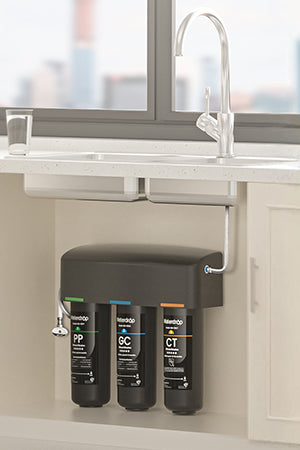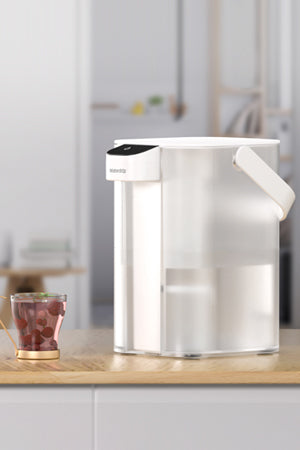One issue most homes deal with is the quality of the water, especially in cities like Singapore. With fears over the presence of impurities in the water that comes through the faucet, more and more people are turning to water purification systems to ensure that they drink 100% pure water. One highly recommended method in water purification is
Reverse Osmosis (RO).
What everyone wants to know is: Can RO water really be 100% pure? In this blog post, let us dig deeper into the RO process, its capability to clean the water, and if indeed it provides water that is 100% pure. We will also touch on how
Waterdrop water filters can become the reliable solution for the home.
What is Reverse Osmosis (RO)?
Reverse Osmosis (RO) is a type of water filtration system using a semi-permeable membrane to filter out many different contaminants in water. It functions by using pressure to push water through the membrane, which screens out molecules, dissolved matter, and other impurities.
How RO Works?
The RO system functions by forcing the water through an extremely thin semi-permeable membrane. Only the water molecules pass through the membrane, but the contaminants including salts, metals, chlorine, bacteria, and other unwanted substances are not allowed through. Clean water gathers on the receiving side, with the contaminants remaining on the other.
Multi-stage filtration: RO often employs several filters in series, including the pre-filter, carbon filter, and the semi-permeable membrane.
Eliminates a variety of impurities: RO has the ability to eliminate between 99% of
the dissolved solids , heavy metals, chlorine, pesticides, as well as other impurities that are dangerous.
Boosts taste and odor: By removing chlorine, chemicals, and other impurities, RO boosts the taste and odor of water, enhancing its drinkability.
Is RO Water 100% Pure?
Though reverse osmosis (RO) is very effective for purifying water, it should be kept in mind that it doesn’t yield water that is 100% pure. The following are the reasons why:
1. There Can Still Be Trace Contaminants
Even though RO has the capability of eliminating 99% of dissolved contaminants and impurities, it will not eliminate 100% of contaminants. There are some contaminants, such as certain
VOCs , that will remain in trace quantities. If the RO system is not maintained either, its ability to eliminate contaminants will begin to diminish.
2. Some RO Water Lacks Essential Minerals
One of the drawbacks of RO water is that it removes not only harmful substances but also beneficial minerals like calcium and magnesium. While these minerals are not harmful, they are important for health and contribute to the taste of water. This means that RO water, though pure in terms of contaminants, might lack the essential minerals found in natural drinking water.
Indeed, the consumption of demineralized water might not turn out to be so healthy for long-term drinking, as the human body needs these minerals for its operations. Some
Waterdrop RO systems also include the mineralization process that reinjects beneficial minerals after the purification process, providing the balance.
3. System Limitations
The effectiveness of an RO system relies on the variables of water pressure, temperature, and the quality of the membrane itself. If the system has not been properly installed or regularly maintained, it will not eliminate all contaminants as efficiently. RO systems also have the potential to waste quite a bit of water, producing roughly 3-4 liters of wastewater for each liter purified. However, the pure to drain ratio of
Waterdrop Reverse Osmosis Hot Cold Water Dispenser A2 is 3:1, saving your water bills.
4. Biological Contaminants May Require Additional Filtration
RO systems are effective at removing a wide range of physical and chemical contaminants, but they may not be as effective at eliminating some biological contaminants. In order to effectively kill bacteria, viruses, and protozoa, an additional UV (ultraviolet) or carbon filter may be required. These systems work together to ensure that both chemical and biological impurities are removed from the water.
Why RO Remains One of the Best Water Purifying Techniques in Singapore
Although RO water is not pure 100%, it is yet one of the best water purifying methods available in the market. This is the reason why RO water is also becoming increasingly favorable among houses in Singapore:
Effective Contaminant Removal
RO systems are effective at eliminating many different contaminants, such as toxic chemicals, heavy metals, chlorine, and pesticides. In Singapore, where water comes either from many reservoirs or desalination plants, RO has the potential to further clean water that has trace contaminants left over after regular municipal treatment.
Safe Drinking Water
Singapore’s tap water is among the cleanest in the world, with frequent testing and treatment to high standards. But RO filtration adds an additional barrier, with the harmful contaminants such as lead, arsenic, and other toxic compounds removed, providing peace of mind for families, particularly those who are worried about contaminants due to aged plumbing or water quality in certain regions.
Improved Taste and Smell
RO filtration also eliminates chlorine, sediment, and other contaminants that may impact the flavor and odor of tap water. With an RO system, homes can have access to fresh-tasting, clean water directly out of the faucet, without the need for bottled water.
Convenience
Having an RO system installed at home offers an always-on and convenient supply of purified water. You no longer need to buy bottled water, which is not just expensive but also damaging to the environment due to the resulting plastic wastes.
Waterdrop Water Filters: Safe Choice for RO Water Purification
If you need an effective, high-performance RO system for home use in Singapore, Waterdrop is an excellent brand to rely on. Their high-tech RO water filters aim to give you pure, safe, and deliciously tasting water.
Why Waterdrop Water Filters?
Sophisticated Filtration System: Waterdrop RO filters employ multi-stage technology to efficiently eliminate contaminants and impurities, so you get clean, safe water.
Mineral Retention: Our Waterdrop RO systems also have the option for mineralization filters, which put beneficial minerals back in the purified water, enhancing flavor and providing health benefits.
Energy-Efficient: Waterdrop filters are energy-saving by nature and help save water, so they are an eco-friendly option for homes in Singapore.
Space-Saving and Simple Installation: Waterdrop water filters occupy limited space and are also not hard to install. They are an excellent option for houses as well as apartments.
By purchasing a Waterdrop RO system, you have the advantage of purified water with no loss of flavor or beneficial minerals. Whether due to contaminants or simply to enhance the quality of the water, Waterdrop provides an efficient and eco-friendly solution.
Conclusion: Is RO Water 100% Pure?
Even though Reverse Osmosis is a wonderful method to purify water, it will not provide you with 100% pure water. RO systems will eliminate contaminants as high as 99%, but trace contaminants will always persist.
But in spite of these shortcomings, RO water is still among the best choices for making sure that the water you drink is safe from unwanted contaminants. In homes in Singapore, an RO system offers an additional sense of protection and assurance, making sure that the water in your home is pure, safe, and delicious.
If you’re looking for a reliable and efficient RO system, Waterdrop is a top choice for Singaporean homes. Their innovative RO filters provide high-quality purification, improved taste, and the option to retain beneficial minerals.




































































